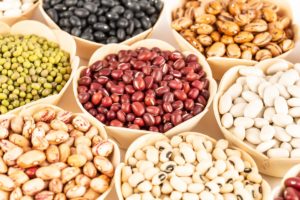How to Cook Beans
 Clean your beans. Spread beans (pulses) on a tray or baking pan. sort to remove stones and debris. Wash in a pot or bowl, and drain through a colander or strainer. Use three changes of water or repeat washing until no dirt is left in the water. To clean very dirty beans, rub the beans between your hands under running water.
Clean your beans. Spread beans (pulses) on a tray or baking pan. sort to remove stones and debris. Wash in a pot or bowl, and drain through a colander or strainer. Use three changes of water or repeat washing until no dirt is left in the water. To clean very dirty beans, rub the beans between your hands under running water.
Benefits of soaking beans before cooking are to reduce cooking times and improve digestibility. Two ways to soak:
Overnight Cold Soak (preferred): Soak beans 6 hours or overnight in enough cold water to cover by 4 inches. Pour off soaking water, rinse, and add fresh water for cooking–covering beans by 2 inches.
Quick Hot Soak: Place beans in a large pot and cover with 4 inches of water. Boil for 2 minutes. Turn off heat and soak for 1 hour. Drain and rinse. Then add fresh water for cooking–covering beans by 2 inches.
Cooking times vary according to bean, its type, size, and age. Bring to a boil, then reduce heat to simmer in a covered pot, cooking until tender.* Add salt (optional) toward end of cooking time. If you add some flavorings and/or vegetables, you have a nice dish that can be served over a whole grain.
Lentils and Split Peas do not need to be soaked. Cook them in at least double amount of water (1:2). Bring to a boil, and then cook at a low simmer in a covered pot for 30 to 45 minutes until tender.*
*With all beans, it is recommended to stay in the kitchen while they cook. An un-watched pot tends to boil over and leave a mess on your stove, even if heat has been turned down.
Beans can also be cooked in a pressure cooker or crockpot; refer to your owner’s manual for instructions.
What Are Beans?
 A bean is a seed which will grow a plant that produces more beans for you to plant or eat. Beans, peas, and lentils are called pulses. Pulses are the seeds of leguminous plants. Bean-plants and all legumes help other plants grow; they use root nodules to fertilize the soil with nitrogen.
A bean is a seed which will grow a plant that produces more beans for you to plant or eat. Beans, peas, and lentils are called pulses. Pulses are the seeds of leguminous plants. Bean-plants and all legumes help other plants grow; they use root nodules to fertilize the soil with nitrogen.
There are many kinds of beans. There are kidney beans, black-eyed peas, great northern beans, black beans, mung beans, split peas, lima beans, and 100s more! Try naming one for each letter of the alphabet.
Eat beans and other legumes everyday as part of a balanced diet that includes plenty of fruits, vegetables, and grains.
Beans, Peas, and Lentils Are Good for You. They have:
Protein for growth
Carbohydrates for energy: The complex carbs provide a slow-release source of energy and lower blood glucose (sugar)
Fiber for good poop
Vitamins for health
Minerals for strong bones (calcium) and good blood (iron)
Phytonutrients called antioxidants to keep you healthy
Beans are low in fat and free of cholesterol!
Beans decrease one’s risk of cardiovascular diseases, making them a heart-healthy food.
Eating more beans can help one to lose weight or maintain weight.
Bean Recipe Ideas 
You can use peas, beans and lentils in many ways:
- Beans and rice
- Succotash (lima beans and corn)
- Bean Dip (click for easy recipe)
- Bean and vegetable stews
- Bean tacos/burritos
- Bean salad
- Bean pie
- Lentil pâté
- Lentil and Quinoa stuffing
- Bean Burgers (click for delicious burger recipe that freezes well)

- Beans on toast
- Bean sandwiches
- Sprout beans for salads and stir-fries
- Peas and carrots
- Minted Peas
- Beans and greens




